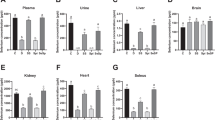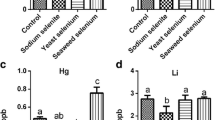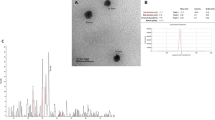Abstract
Selenium, an essential trace element, is known to have several health benefits. Dietary selenium sources include both organic and inorganic forms, however organic forms are more digestible and less toxic than inorganic forms. Microalgae have been considered as food in different parts of the world for decades. They recently gained popularity in the food and nutraceutical industry because of the presence of highly valued compounds. The current study investigates the efficacy of organic selenium-enriched edible microalga Nannochloropsis oceanica CASA CC201 as a dietary selenium supplement by testing its bioavailability, toxicity, and antioxidant properties in Wistar rats. The study showed that organic selenium-enriched N. oceanica CASA CC201 was not toxic to the animals. Further, organic selenium-enriched microalga promoted the growth of the organism significantly. It helped to reduce cholesterol and low-density lipoprotein (LDL) compared to the control. No abnormal pathological conditions were observed in any experimental group during the study. A significant accumulation of selenium was observed in the Serum and tissues of the organic Se-fed group. The organic Se-fed group showed significantly lower oxidative stress marker malondialdehyde (MDA) levels than in other tested groups. In addition, catalase activity in the liver was higher in the organic-Se-fed group than in the oxidative stress-induced group fed with the known antioxidant silymarin. The study demonstrated that the organic Se-enriched N. oceanica CASA CC201 could be an effective dietary Se supplement.











Similar content being viewed by others
Data availability
Available data are provided in the publication. All other relevant data are available from the corresponding authors upon reasonable request.
References
Ahmed T, Hudeda S (2018) In-vivo antioxidant potentials of Citrullus colocynthis schard in rotenone induced Parkinson’s disease animal model. Int J Adv Res Publ 2:56–60
Al-Rasheed NM, Attia HA, Mohamed RA, Al-Rasheed NM, Al-Amin MA (2013) Preventive effects of selenium yeast, chromium picolinate, zinc sulfate and their combination on oxidative stress, inflammation, impaired angiogenesis and atherogenesis in myocardial infarction in rats. Int J Pharm Pharm Sci 16:848–867
Arumugam M (2022) Advanced technologies and perspectives on sustainable microalgae production. Front Bioeng Biotech 10:841261
Arumugam M, Aswathy U, Hariharan S, Abraham B (2021) Plant growth regulator triggered metabolomic profile leading to increased lipid accumulation in an edible marine microalga. J Appl Phycol 33:1353–1365
Burk RF (1990) Protection against free radical injury by selenoenzymes. Pharmacol Therapeut 45:383–385
Cases J, Vacchina V, Napolitano A, Caporiccio B, Pierre B, Lobinski R, Rouanet J (2001) Selenium from selenium-rich Spirulina is less bioavailable than selenium from sodium selenite and selenomethionine in selenium-deficient rats. J Nutr 131:2343–2350
Cases J, Wysocka IA, Caporiccio B (2002) Assessment of selenium bioavailability from high-selenium Spirulina subfractions in selenium-deficient rats. J Ag Food Chem 50:3867–3873
Çay M, Naziroğlu M (1999) Effects of intraperitoneally-administered vitamin E and selenium on the blood biochemical and haematological parameters in rats. Cell Biochem Funct 17:143–148
Chan YH, Siu CW, Yiu KH, Chan HT, Li SW, Tam S, Cheung BM, Lau CP, Lam TH, Tse HF (2012) Adverse systemic arterial function in patients with selenium deficiency. J Nutr Health Aging 16:85–88
Crespo AM, Lanca MJ, Vasconcelos S, Andrade V, Rodrigues H, Santos MC (1995) Effect of selenium supplementation on some blood biochemical parameters in male rats. Biol Trace Elem Res 47:343–347
Duntas LH, Benvenga S (2015) Selenium: an element for life. Endocrine 48:756–775
Finley JW, Davis CD, Feng Y (2000) Selenium from high selenium broccoli protects rats from colon cancer. J Nutr 130:2384–2389
Fu LH, Wang XF, Eyal Y, She YM, Donald LJ, Standing KG, Ben-Hayyim G (2002) A selenoprotein in the plant kingdom: mass spectrometry confirms that an opal codon (UGA) encodes selenocysteine in Chlamydomonas reinhardtii glutathione peroxidase. J Biol Chem 277:25983–25991
Gaweł S, Wardas M, Niedworok E (2004) Malondialdehyde (MDA) as a lipid peroxidation marker. Wiad Lek 57:453–455
Guo L, Xiao J, Liu H, Liu H (2020) Selenium nanoparticles alleviate hyperlipidemia and vascular injury in ApoE-deficient mice by regulating cholesterol metabolism and reducing oxidative stress. Metallomics 12:204–217
Hu ML, Chung C, Spallholz JE (1984) Hematologic data of selenium-deficient and selenium-supplemented rats. J Inorg Biochem 22:165–173
Hurt HD, Cary EE, Visek WJ (1971) Growth, reproduction, and tissue concentrations of selenium in the selenium-depleted rat. J Nutr 101:761–766
Ihedioha JI, Noel-Uneke OA, Ihedioha TE (2013) Reference values for the serum lipid profile of albino rats (Rattus norvegicus) of varied ages and sexes. Comp Clin Path 22:93–99
Ismaiil LA, Joumaa WH, Moustafa ME (2019) Selenium decreases triglycerides and VLDL-c in diabetic rats exposed to electromagnetic radiation from mobile phone base stations. J Taibah Univ Med Sci 13:844–849
Jacob Filho W, Lima CC, Paunksnis MRR, Silva AA, Perilhão MS, Caldeira M, Bocalini D, de Souza RR (2018) Reference database of hematological parameters for growing and aging rats. Aging Male 21:145–148
Jaslin E, Padmaja V (2012) Evaluation of antioxidant activity of aerial part extract of Coleus spicatus. Benth on chromium (VI) induced oxidative stress in albino rats. Int J Pharm Tech Res 4:1745–1749
Jones GD, Droz B, Greve P, Gottschalk P, Poffet D, McGrath SP, Seneviratne SI, Smith P, Winkel LH (2017) Selenium deficiency risk predicted to increase under future climate change. Proc Nat Acad Sci 114:2848–2853
Kang BPS, Bansal MP, Mehta U (1998) Selenium supplementation and diet induced hypercholesterolemia in the rat: changes in lipid levels, malonyldialdehyde production and the nitric oxide synthase activity. Gen Physiol Biophys 17:71–78
Merghem M, Dahamna S, Khennouf S (2019) In vivo antioxidant activity of Rutamontana L. extracts. J Mater Environ Sci. 10:470–477
Reshma R, Arumugam M (2017) Selective degradation of the recalcitrant cell walls of Scenedesmus quadricauda CASA CC202. Planta 246:779–790
Reshma R, Kumari S, Arumugam M (2021) Structural elucidation of selenocysteine insertion machinery of microalgal selenoprotein T and its transcriptional analysis. Biotech Appl Biochem 68:636–647
Reshma R, Arumugam M (2022) Organic selenium fortification in edible marine microalga Nannochloropsis oceanica CASA CC201 for food and feed applications. Algal Res 66:102787
Rambjør GS, Windsor SL, Harris WS (1996) Eicosapentaenoic acid is primarily responsible for hypotriglyceridemic effect of fish oil in humans. Lipids 31:S45–S49
Reeves PG, Leary PD, Gregoire BR, Finley JW, Lindlauf JE, Johnson LK (2005) Selenium bioavailability from buckwheat bran in rats fed a modified AIN-93G torula yeast–based diet. J Nutr 135:2627–2633
Sartori Oliveira CE, Pinton S, da Rocha JT, Gai BM, Nogueira CW (2016) The hypolipidemic action of a diet supplemented with p,p’-methoxyl-diphenyl diselenide is not directly related to its antioxidant property. Can J Physiol Pharmacol 94:662–668
Schiavon M, Nardi S, Dalla Vecchia F, Ertni A (2020) Selenium biofortification in the 21st century: status and challenges for healthy human nutrition. Plant Soil 453:245–270
Semba RD, Ferrucci L, Cappola AR, Ricks MO, Ray AL, Xue QL, Guralnik JM, Fried LP (2006) Low serum selenium is associated with anemia among older women living in the community. Biol Trace Elem Res 112:97–107
Sochor J, Pohanka M, Ruttkay-Nedecky B, Zitka O, Hynek D, Mares P, Zeman L, Adam V, Kizek R (2012) Effect of selenium in organic and inorganic form on liver, kidney, brain and muscle of Wistar rats. Open Chem 10:1442–1451
Soudani N, Amara IB, Troudi A, Hakim A, Bouaziz H, AyadiMakni F, Zeghal KM, Zeghal N (2011) Oxidative damage induced by chromium(VI) in rat erythrocytes: protective effect of selenium. J Physiol Biochem 67:577–588
Sunde RA, Evenson JK, Thompson KM, Sachdev SW (2005) Dietary selenium requirements based on glutathione peroxidase-1 activity and mRNA levels and other Se-dependent parameters are not increased by pregnancy and lactation in rats. J Nutr 135:2144–2150
Thiry C, Ruttens A, Pussemier L, Schneider YJ (2013) An in vitro investigation of species-dependent intestinal transport of selenium and the impact of this process on selenium bioavailability. Br J Nutr 109:2126–2134
Udayan A, Arumugam M (2017) Selective enrichment of eicosapentaenoic acid (20:5n–3) in N. oceanica CASA CC201 by natural auxin supplementation. Bioresour Technol 242:329–333
Van Nhien N, Yabutani T, Khan NC (2009) Association of low serum selenium with anemia among adolescent girls living in rural Vietnam. Nutrition 25:6–10
Van Vleet JF (1980) Current knowledge of selenium-vitamin E deficiency in domestic animals. J Am Vet Med Assoc 176:321–325
Yang JG, Hill KE, Burk RF (1989) Dietary selenium intake controls rat plasma selenoprotein P concentration. J Nutr 119:1010–1012
Funding
The work supported by the grant from the Department of Science and Technology-SERB, Government of India through the Core Research Grant Project "CRG/2019/001913: Investigation on identification and biochemical validation of selenoproteins from Nannochloropsis oceanica CASA CC201 as functional food/feed supplements" to M.A. We are thankful for the financial support from the DBT-JRF program of the Department of Biotechnology, New Delhi, for doctoral studies of R.R.
Author information
Authors and Affiliations
Contributions
M.A. planned and designed the experiments; funding acquisition. R.R. conducted the experiments and collected and analyzed the data. R.R. prepared the manuscript draft. M.A. corrected and communicated the manuscript. All authors read and approved the final manuscript.
Corresponding author
Ethics declarations
Informed consent, human/animal rights
The experiment was approved by Institutional Animal Ethics Committee (IAEC) under the Committee for Control and Supervision of Experiments on Animals (CPCSEA), India. (IAEC No. CBLRC/IAEC/07/01–2019 & IAEC No.CBLRC/IAEC/14/01–2019).
Competing interest
The authors declare that they have no known competing financial interests or personal relationships that could have appeared to influence the work reported in this paper.
Additional information
Publisher's note
Springer Nature remains neutral with regard to jurisdictional claims in published maps and institutional affiliations.
Rights and permissions
Springer Nature or its licensor (e.g. a society or other partner) holds exclusive rights to this article under a publishing agreement with the author(s) or other rightsholder(s); author self-archiving of the accepted manuscript version of this article is solely governed by the terms of such publishing agreement and applicable law.
About this article
Cite this article
Ragini, R., Arumugam, M. In vivo studies on bioavailability, toxicity, and antioxidant defense of organic selenium-enriched microalga biomass in Wistar rats. J Appl Phycol 35, 1699–1713 (2023). https://doi.org/10.1007/s10811-023-03007-x
Received:
Revised:
Accepted:
Published:
Issue Date:
DOI: https://doi.org/10.1007/s10811-023-03007-x




